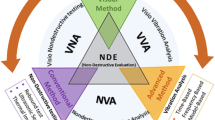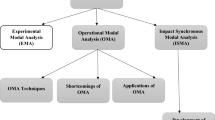Abstract
Purpose
This paper provides a novel method to split up the multiple coherence function into noise, nonlinear distortion, and transient components.
Method
The method relies on the nonparametric estimation framework called the Best Linear Approximation (BLA) where vibro-acoustic systems are excited by special so-called multisines (pseudo-random noise) signals.
Challange
Testing of multiple-input, multiple-output (MIMO) nonlinear systems is very involved, and it usually requires expert users. It is because the design and processing of experiments, and nonlinear assessment are not trivial questions.
Proposal
To cope with these issues, this paper shows the recent results of a research project addressing the questions related to the user-friendly nonlinear (pre-)processing of MIMO experiments of vibrating structures. The key idea is the novel analysis of the (co-)variance estimates of the BLA framework that can be tailored to split up the classical multiple coherence function into noise, nonlinearity, and transient components.
Conclusions
Using the suggested approach, a novice user can quickly determine whether the underlying structure is linear or not, and how much is the possible gain using nonlinear modeling tools.
Illustration
The proposed approach is demonstrated on, but not limited to, the analysis of ground vibration testing of a decommissioned F-16 fighting falcon.











Similar content being viewed by others
References
Kerschen G, Worden K, Vakakis AF, Golinval J-C (2006) Past, present and future of nonlinear system identification in structural dynamics. Mech Syst Signal Process 20(3):505–592
Worden K, Tomlinson GR (2001) Nonlinearity in structural dynamics: detection, identification and modelling. Institute of Physics Publishing, Bristol
Schoukens J, Godfrey K, Schoukens M (2019) Nonparametric data-driven modeling of linear systems: estimating the frequency response and impulse response function. IEEE Control Syst Mag 38(4):49–88
Schoukens J, Ljung L (2019) Nonlinear system identification: a user-oriented road map. IEEE Control Syst Mag 39(6):28–99
Fargette P, Füllekrug U, Gloth G, Levadoux B, Lubrina P, Schaak H, Sinapius M (2001) Tasks for improvement in ground vibration testing of large aircraft. In: Proceedings of IFASD 2001 International Forum on Aeroelasticity and Structures Dynamics, Madrid
Lubrina P (2003) Ground vibration experiments on large civil aircraft for engine imbalance purpose. In: IFASD 2003 International Forum on Aeroelasticity and Structures Dynamics, Amsterdam
Climent H (2007) Aeroelastic and structural dynamics tests at EADS CASA. In: the 18th Annual Symposium of the Society of Flight Test Engineers SFTE, Madrid
Pickrel CR, Foss GC, Phillips A, Allemang RJ, Brown DL (2006) New concepts GVT. In: IMAC 24 Int. Modal Analysis Conference, St. Louis (MO)
Van Der Auweraer H, Otte D, Leuridan J, Bakkers W (1991) Modal testing with multiple sinusoidal excitation. In: IMAC 9 International Modal Analysis Conference, Firenze
Otte D, Van Der Auweraer H, Debille J, Leuridan J (1993) Enhanced force vector appropriation methods for normal mode testingm Los Angeles. Int. Modal Analysis Conf 1923:1310–1316
Schoukens J, Pintelon R, Rolain Y (2012) Mastering System Identification in 100 exercises. John Wiley & Sons, New Jersey
Lauwers L, Schoukens J, Pintelon R, Enqvist M (2006) Nonlinear structure analysis using the best linear. In: Proceedings of International Conference on Noise and Vibration Engineering, Leuven
Esfahani A, Schoukens J, Vanbeylen L (2016) Using the best linear approximation with varying excitation signals for nonlinear system characterization. IEEE Trans Instrum Meas 65:1271–1280
Wong HK, Schoukens J, Godfrey K (2012) Analysis of best linear approximation of a wiener-hammerstein system for arbitrary amplitude distributions. IEEE Trans Instrum Meas 61(3):645–654
Schoukens J, Pintelon R (2010) Study of the variance of parametric estimates of the best linear approximation of nonlinear systems. IEEE Trans Instrum Meas 59(12):3156–3167
Schoukens J, Vaes M, Pintelon R (2016) Linear system identification in a nonlinear setting. nonparametric analysis of the nonlinear distortions and their impact on the best linear approximation. IEEE Control Syst Mag 36:38–69
Dobrowiecki T, Schoukens J, Guillaume P (2006) Optimized excitation signals for MIMO frequency function measurements. IEEE Trans Instrum Meas 55:2072–2079
Dobrowiecki T, Schoukens J (2004) Linear approximation of weakly nonlinear MIMO systems. In: IEEE International Instrumentation and Measurement Technology Conference (I2MTC), pp 1607–1612
Schoukens J, Pintelon R, Vandersteen G, Rolain Y (2010) Design of excitation signals for nonparametric measurements on MIMO-systems in the presence of nonlinear distortions. In: IEEE International Instrumentation and Measurement Technology Conference, Austin
Pintelon R, Schoukens J (2012) System identification: a frequency domain approach, 2nd edn. Wiley-IEEE Press, New Jersey
Csurcsia PZ, Peeters B, Schoukens J (2020) User-friendly nonlinear nonparametric estimation framework for vibro-acoustic industrial measurements with multiple inputs. Mech Syst Signal Process 145:106926
Gómez González A, Rodríguez J, Sagartzazu X, Schumacher A, Isasa I (2010) Multiple coherence method in time domain for the analysis of the transmission paths of noise and vibrations with non-stationary signals. In: International Vibration and Noise Conference, Leuven, Belgium
Csurcsia PZ, Peeters B, Schoukens J, De Troyer T (2020) Simplified analysis for multiple input systems: a toolbox study illustrated on F-16 measurements. Vibration 3(2):70–84
Csurcsia P, de Troyer T (2021) An empirical study on decoupling PNLSS models illustrated on an airplane. IFAC-Papers Online 7(673–678):54
Csurcsia P, Peeters B, Schoukens J (2020) The best linear approximation of MIMO systems: Simplified nonlinearity assessment using a toolbox. In: Proceedings of ISMA 2020 - International Conference on Noise and Vibration Engineering and USD 2020 - International Conference on Uncertainty in Structural Dynamics, Leuven, Belgium
Csurcsia PZ, Lataire J (2016) Nonparametric estimation of time-variant systems using 2D regularization. IEEE Trans Instrum Meas 65(5):1259–1270
Csurcsia PZ, Schoukens J, KollárI (2012) Identification of time-varying systems using a two-dimensional B-spline algorithm. In: 2012 IEEE International Instrumentation and Measurement Technology Conference, Graz, Austria
Csurcsia PZ, Schoukens J, Kollár I (2013) A first study of using B-splines in nonparametric system identification. In: IEEE 8th International Symposium on Intelligent Signal Processing, Funchal, Portugal
Csurcsia PZ (2013) Static nonlinearity handling using best linear approximation: an introduction. Pollack Period 8(1):153–165
Heylen W, Sas P (2005) Modal Analysis Theory and Testing. Lirias, Leuven
Kay SM (1988) Modern spectral estimation: theory and application. Prentice Hall Signal Processing Series, London
Peeters B, El-Kafafy M, Guillaume P, Van der Auweraer H (2014) Uncertainty propagation in experimental modal analysis. In: Conference Proceedings of the Society for Experimental Mechanics Series
Csurcsia PZ, Peeters B, Schoukens J (2019) The best linear approximation of MIMO Systems: first results on simplified nonlinearity assessment. In: IMAC International Modal Analysis Conference, Orlando
Cornelis B, Toso A, Verpoest W, Peeters B (2014) Improved MIMO FRF estimation and model updating for robust time waveform replication on durability test rigs. In: International Conference on Noise and Vibration Engineering, Leuven
Noël JP, Schoukens M (2017) F-16 aircraft benchmark based on ground vibration test data. In: 2017 Workshop on Nonlinear System Identification Benchmarks, Brussels, Belgium, 2017.
Csurcsia PZ, Decuyper J, Troyer TD (2022) Nonlinear modelling of an F16 benchmark measurement. In: Conference Proceedings of the Society for Experimental Mechanics Series, Florida, U.S., 2022.
Dossogne T, Noël J, Grappasonni C, Kerschen G, Peeters B, Debille J, Vaes M, Schoukens J (2015) Nonlinear ground vibration identification of an F-16 aircraft - part II understanding nonlinear behaviour in aerospace structures using sine-sweep testing. In: Conference: International Forum on Aeroelasticity and Structural Dynamics, Saint Petersburg, Russia
Acknowledgements
This work was funded by the Strategic Research Program SRP60 of the Vrije Universiteit Brussel.
Author information
Authors and Affiliations
Corresponding author
Ethics declarations
Conflict of interest
The author declares that they have no conflict of interest. The datasets generated during and/or analyzed during the current study are available from the corresponding author on reasonable request.
Additional information
Publisher's Note
Springer Nature remains neutral with regard to jurisdictional claims in published maps and institutional affiliations.
Rights and permissions
About this article
Cite this article
Csurcsia, P.Z. User-Friendly Method to Split Up the Multiple Coherence Function Into Noise, Nonlinearity and Transient Components Illustrated on Ground Vibration Testing of an F-16 Fighting Falcon. J. Vib. Eng. Technol. 10, 2577–2591 (2022). https://doi.org/10.1007/s42417-022-00505-z
Received:
Revised:
Accepted:
Published:
Issue Date:
DOI: https://doi.org/10.1007/s42417-022-00505-z




